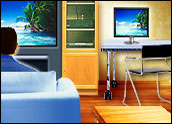
“The connected home” is a term used frequently but often defined ambiguously. For Parks Associates, the connected home is comprised of the following elements:
- access services, including broadband, television, landline communications, and mobile services
- content and value-added services that complement the core access services
- Devices that connect to these access services and each other, creating a network that can share content and resources throughout the home
Consumer electronics manufacturers, the PC industry, pay-television service providers and broadband providers are driving the development of the connected home, for obvious reasons, as the interplay of these elements expands the businesses for all these players.
Parks Associates categorizes the major business strategies involved in the connected home efforts as follows.
Connected Consumer Electronics
There are two trends driving home networking of consumer electronics: the growth of stored media collections on home servers and the influx of online content services, particularly over-the-top video from Hulu, Xbox Live and other sources.
Pay TV
As pay-television providers face increasing competition from new entrants and programming alternatives (such as free-to-air and online), they are developing connected home efforts that allow subscribers to access content and unique services in new ways.
U.S. service providers AT&T and Verizon have been active in deploying whole-home DVRs to subscribers, and both Verizon and Virgin Media are working to provision online video content to television sets. Pay-TV providers are also exploring home network connections between set-top boxes and home computers to allow subscribers to pull libraries of their own content (music, photos, and video) to their televisions. Verizon already offers this feature through the Home Media DVR and the Media Manager software.
The Residential Gateway
More and more broadband and triple-play service providers are using residential gateways to terminate broadband access services. These devices can help to configure and manage home network settings, they can reduce or prevent customer support calls, and they can serve as launching points for new connected home services.
Parks Associates has been looking at the connected home for some time, and in 2009 we have taken several different approaches to provide the most comprehensive analysis possible of this market.
Parks Associates analyzes the connected home market for connected consumer electronics and defines the two key use cases for connected CE.
One, the media server capability, accounts for the prodigious quantities of digital media consumers are collecting, from digital photos to MP3s, and enables sharing and backup throughout the home.
The second use case, “cloud media” content-receiving capabilities, connects CE to access services, where devices can receive premium content and services located in the cloud. This report looks at these scenarios as they relate to products such as connected TVs and Blu-ray players, alternative set-top boxes, digital media adapters, network-attached storage devices, and whole-home DVRs.
The Changing Role of the Set-Top
Other research covers connected home developments from pay-TV service providers as delivered through set-top boxes. Key technology trends and business requirements are shaping the market for the next-generation set-top box — namely increased competition combined with the need to reduce CAPEX. TV viewing habits are changing, and the set-top is expanding in its role and capabilities to accommodate.
Parks Associates addresses consumer interest in connected set-top boxes and their willingness to pay for advanced set-tops. Already one-third of U.S. broadband households find a networked set-top box appealing, a strong showing considering we are in the early stages of this product category. This strong interest will lead to higher numbers of consumers willing to pay a monthly fee (US$3-6) to have this device, which is currently less than 10 percent.
Our research provides analysis on the deployment of home networking solutions by worldwide broadband and bundled services providers. It focuses on the role of residential gateways in delivering value-added features and includes an overview of their underlying technologies:
- Service provisioning
- Service management
- Device management
- Applications development and execution
For operators, the clear benefit for managed residential gateways is in saving operational expenses. By automating the diagnostics and troubleshooting of the broadband modem and residential gateway, they are able to eliminate or at least shorten customer support calls.
The operators automate in two ways: The modems are auto-configurable for both initial service activation and service upgrades, and the provider can automatically detect and solve home networking configuration issues without the subscriber’s knowledge. Operators that deploy remotely configurable and manageable residential gateways are realizing operational cost savings north of 30 percent due to reduced phone calls and truck rolls.
From the consumer perspective, a managed residential gateway’s benefits are in the basic home networking functions — broadband sharing, printer sharing, centralized media management and sharing — that typify home network use today (at least in today’s market).
The true benefit in the RG is in its ability to expand. With the RG in place, operators will be able to expand future services to subscribers, offering seemingly ubiquitous access to content as well as other fields of services. Operators will find significant traction by creating multidevice services around four major value-added service categories:
- Entertainment
- Lifestyle
- Premium Technical Support
- Home and Health Management
For the operators, the long-term benefits, beyond having happy customers, include reduction in CAPEX, efficient application development and deployment, and the role of the RG as a DRM/CA mediator.
Kurt Scherf is a vice president of research at Parks Associates.





































Social Media
See all Social Media